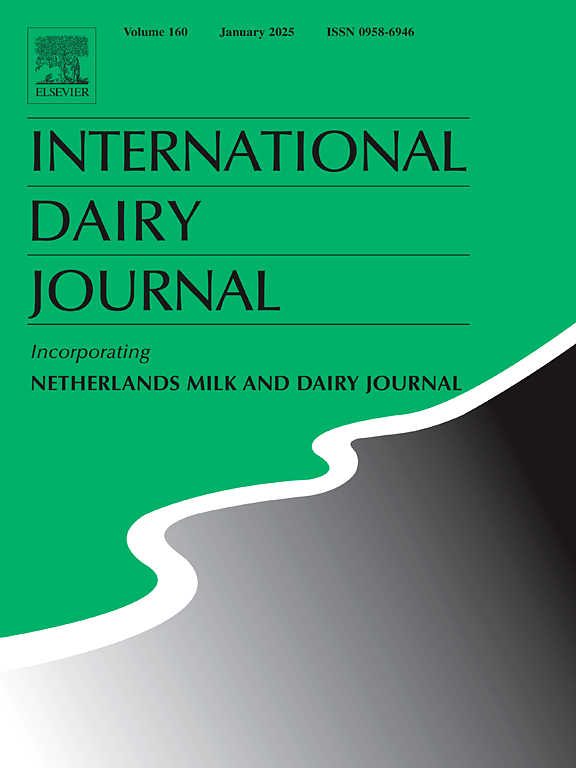从初乳到成熟乳饮食变化过程中大熊猫新生儿肠道微生物组分析
IF 3.1
3区 农林科学
Q2 FOOD SCIENCE & TECHNOLOGY
引用次数: 0
摘要
母乳对圈养大熊猫的生长是不可替代的,但很少有研究评估母乳在不同哺乳期对新生儿肠道微生物群发育的潜在影响。本研究观察了大熊猫新生儿从初乳过渡到成熟乳时肠道微生物组成的实质性差异。在成年大熊猫的肠道中发现了丰度较高的厚壁菌门、放线菌门、拟杆菌门、蓝藻门和酸杆菌门细菌。相比之下,大肠杆菌属、克雷伯氏菌属、链球菌、葡萄球菌、弯曲杆菌属、不动杆菌属、乳酸杆菌属和聚合杆菌属在幼崽样本中出现的丰度高于其亲本样本。值得注意的是,当大熊猫从初乳过渡到成熟乳时,肠道微生物群结构的连续变化是明显的。具体来说,初乳增加了幼崽中拟杆菌、瘤胃球菌和乳酸杆菌的丰度。食用成熟乳的幼崽微生物多样性增加,肠杆菌科、红杆菌科和小单孢子菌科增加。本文章由计算机程序翻译,如有差异,请以英文原文为准。
Gut microbiome analysis in giant panda newborns during the dietary changing from colostrum to mature milk
Breast milk is irreplaceable for captive giant panda growth, while few studies have been conducted to evaluate the potential impacts of breast milk at different stages of lactation on the development of the gut microbiome in newborns. This study observed substantial differences in gut microbial composition of giant panda newborns as they transitioned from colostrum to mature milk. Higher abundances of bacteria belonging to the phyla Firmicutes, Actinobacteria, Bacteroidetes, Cyanobacteria, and Acidobacteria were observed in the gut of adult pandas. In contrast, genus Escherichia, Klebsiella, Streptococcus, Staphylococcus, Campylobacter, Acinetobacter, Lactobacillus, and Aggregatibater, emerged in higher abundance of cubs’ samples than in their parental samples. Notably, successive changes in the gut microbiome structure were evident as the pandas transitioned from colostrum to mature milk. Specifically, colostrum milk increased the abundance of Bacteroides, Ruminococcus and Lactobacillus in cubs. Cubs eaten mature milk had increased microbial diversity and Enterobacteriaceae, Erythrobacteraceae and Micromonosporaceae.
求助全文
通过发布文献求助,成功后即可免费获取论文全文。
去求助
来源期刊

International Dairy Journal
工程技术-食品科技
CiteScore
6.50
自引率
9.70%
发文量
200
审稿时长
49 days
期刊介绍:
The International Dairy Journal publishes significant advancements in dairy science and technology in the form of research articles and critical reviews that are of relevance to the broader international dairy community. Within this scope, research on the science and technology of milk and dairy products and the nutritional and health aspects of dairy foods are included; the journal pays particular attention to applied research and its interface with the dairy industry.
The journal''s coverage includes the following, where directly applicable to dairy science and technology:
• Chemistry and physico-chemical properties of milk constituents
• Microbiology, food safety, enzymology, biotechnology
• Processing and engineering
• Emulsion science, food structure, and texture
• Raw material quality and effect on relevant products
• Flavour and off-flavour development
• Technological functionality and applications of dairy ingredients
• Sensory and consumer sciences
• Nutrition and substantiation of human health implications of milk components or dairy products
International Dairy Journal does not publish papers related to milk production, animal health and other aspects of on-farm milk production unless there is a clear relationship to dairy technology, human health or final product quality.
 求助内容:
求助内容: 应助结果提醒方式:
应助结果提醒方式:


